Fall 2023
Now that the summer rush is over, Museum members get back to other activities.
 The Harvard is stripped down to bare essentials for an inspection.
The Harvard is stripped down to bare essentials for an inspection.
 Bill stands by his handywork - the fitting out of the fuselage of the J3C65.
Interior paint is followed by the fitting of the controls.
Bill stands by his handywork - the fitting out of the fuselage of the J3C65.
Interior paint is followed by the fitting of the controls.
 An aircraft is not finished until the instruments are installed.
Here the Cub instrument panel is prepared for service.
An aircraft is not finished until the instruments are installed.
Here the Cub instrument panel is prepared for service.
 And here is one of the original instruments that has been recertified as serviceable.
Note the Cub label!
And here is one of the original instruments that has been recertified as serviceable.
Note the Cub label!
 This Franklin 4-cylinder engine was an optional engine for the Cub. It is being prepared for display.
This Franklin 4-cylinder engine was an optional engine for the Cub. It is being prepared for display.
 But let's not forget the jet-set! The Museum's CF-100 veteran jet fighter had suffered deterioration
to its lower rudder from the elements. Skilled sheet metal specialists prepard a new skin.
Summer 2023
Museum crews spend a lot of time carrying out activities that are not obvious to the casual observer. Our flight-worthy aircraft are maintained to the same standards as private and commercial aircraft.
This includes an annual inspection of the whole aircraft followed by test flights and training flights.
But let's not forget the jet-set! The Museum's CF-100 veteran jet fighter had suffered deterioration
to its lower rudder from the elements. Skilled sheet metal specialists prepard a new skin.
Summer 2023
Museum crews spend a lot of time carrying out activities that are not obvious to the casual observer. Our flight-worthy aircraft are maintained to the same standards as private and commercial aircraft.
This includes an annual inspection of the whole aircraft followed by test flights and training flights.
 The Museum's SE5a gets the engine run by Geoff Guest after an inspection.
The Museum's SE5a gets the engine run by Geoff Guest after an inspection.
 And what can go wrong with a non-flying display aircraft? Age can weary its replica bones.
And what can go wrong with a non-flying display aircraft? Age can weary its replica bones.
This shows the rework of the 130 hp Clerget 9-cylinder rotary engine
with some parts made by a 3D printer.
Spring 2023
What do volunteers at the Museum do on these cool, rainy spring days? They keep busy with all the usual Museum volunteer activities, such as conducting tours of professional engineers, Air Cadets and our senior's groups. Some get involved in messing with aircraft - flyable types and static display models.
 The Sopwith Pup has its engine run, with the Museum's SE5a in the background.
The Sopwith Pup has its engine run, with the Museum's SE5a in the background.
 In the workshop the repair to the complex CF-100 rudder is progressing steadily.
In the workshop the repair to the complex CF-100 rudder is progressing steadily.
 In the hangar the Sopwith Camel wing centre-section gets some attention. The replica,
In the hangar the Sopwith Camel wing centre-section gets some attention. The replica,
built to original plans, but not of airworthy material, has had the structure reinforced.
 Here the centre-section is shown being covered with new fabric.
Here the centre-section is shown being covered with new fabric.
 And now for the finishing touches - Chris and Dave prepare for the coats of finish
And now for the finishing touches - Chris and Dave prepare for the coats of finish
to protect it from the elements.
For more on the Camel, go to:
Reorganizing the Hangar display
Recently the hangar was emptied for a private function. Have you ever wondered how all those aircraft are arranged in the limited space? Very carefully is the short answer. Most of the vintage aircraft are of the 'wood and fabric' variety and are very fragile. Many of them are flight-worthy and any damage means an inspection and repair program up to the highest aviation standards. Handling the aircraft, both in removal from the hangar and the subsequent replacement in the hangar is the result of careful planning and gentle handling. No big tractors or power towbars for this collection!
While the aircraft were outside, maintenance was accomplished on the Waco AQC and the Fleet Finch.
 The Fleet Finch (left) and the Waco AQC were tied down in the fresh air.
A plan for bringing the flock back into shelter was developed by the President and accomplished with lots of discussion, "Wouldn't this look better over here....?" Gradually, the hangar was refilled with aircraft, the movable displays relocated strategically and signage put in place. Well done team!
The Fleet Finch (left) and the Waco AQC were tied down in the fresh air.
A plan for bringing the flock back into shelter was developed by the President and accomplished with lots of discussion, "Wouldn't this look better over here....?" Gradually, the hangar was refilled with aircraft, the movable displays relocated strategically and signage put in place. Well done team!
 The Waco AQC is gently moved back into the hangar.
The Waco AQC is gently moved back into the hangar.
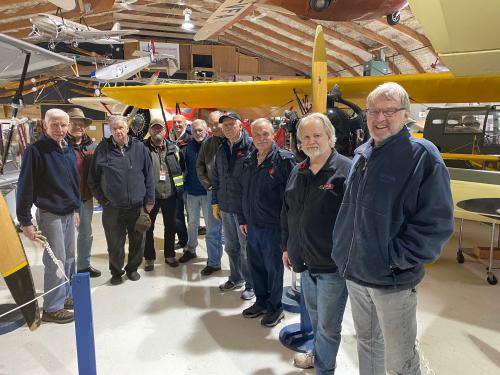 The Hangar team after the job was done. Many thanks to
Ed, Adriaan, Jim, Alf, Mike, Bruce2, Bill, Dave, Bruce3, Tim and President Bruce1.
Volunteer Activities
Not all of the Museum's aircraft are wood and fabric. One classic aircraft on display in the courtyard is the Canadian designed and built Avro CF-100. Living outside is not kind to metal aircraft and the lower rudder of the CF-1oo has deteriorated due to its magnesium skin. The Museum's technical crew have removed the rudder and it is now being restored!
Read more about the CF-100 in the Collection section...
The Hangar team after the job was done. Many thanks to
Ed, Adriaan, Jim, Alf, Mike, Bruce2, Bill, Dave, Bruce3, Tim and President Bruce1.
Volunteer Activities
Not all of the Museum's aircraft are wood and fabric. One classic aircraft on display in the courtyard is the Canadian designed and built Avro CF-100. Living outside is not kind to metal aircraft and the lower rudder of the CF-1oo has deteriorated due to its magnesium skin. The Museum's technical crew have removed the rudder and it is now being restored!
Read more about the CF-100 in the Collection section...
 The CF-100 lower rudder after removal. Watch this space for progress!
The CF-100 lower rudder after removal. Watch this space for progress!
 Robert is making progress by fashioning a new skin of 0.032 inch aluminum.
Canadians in Flight
Robert is making progress by fashioning a new skin of 0.032 inch aluminum.
Canadians in Flight
 Ready for take-off on its return trip, the second edition of Canadians in Flight once again celebrates the people, planes and technologies that have allowed Canada’s reputation for innovation to soar. Since the early days of flight, Canadians have made global advances in the fields of aviation and aeronautics, with some contributions remaining the foundation for ongoing advancement in these fields.
Ready for take-off on its return trip, the second edition of Canadians in Flight once again celebrates the people, planes and technologies that have allowed Canada’s reputation for innovation to soar. Since the early days of flight, Canadians have made global advances in the fields of aviation and aeronautics, with some contributions remaining the foundation for ongoing advancement in these fields.
One of Canada’s first female bush pilots, Toronto-born Violet (Vi) Milstead (1919-2014) earned her private pilot’s licence in 1939, followed by her commercial licence and instructor’s rating, and taught at Toronto’s Barker Field. During the Second World War, she joined Britain’s Air Transport Auxiliary, ferrying military aircraft – everything from single-engined fighters to large multi-engined bombers – between the factories and frontline squadrons. After the war, she married and moved to Sudbury, instructing and flying as a bush pilot.
The de Havilland Canada DHC-2 Beaver made its first flight on August 16, 1947, and by the time production ended in 1968, the company had produced 1,692 of the bush planes, delivered to 62 countries. With its short take-off and landing capability, flexibility to be fitted with wheels, floats or skis, and ability to carry up to nine passengers or bulk cargo, the Beaver is considered the best bush plane ever built.
The Engineering Centennial Board named it one of Canada’s top ten engineering achievements of the 20th century. Pilots around the world can thank Canadian flight-simulator technology for their highly specialized training.
Former Royal Canadian Air Force officer Kenneth Patrick (1915-2002) brought the technology to Canada through CAE Inc. (then Canadian Aviation Electronics Ltd.) – the company he founded in 1947. CAE built its first flight simulator in the early 1950s and by the early 1980s had developed a flight simulator so realistic that it was no longer necessary for all flight training to be completed on an actual aircraft.
Born in Saint John, New Brunswick, pioneering aeronautical engineer Wallace Rupert Turnbull (1870-1954) built Canada’s first wind tunnel in 1902 and spent the next decade researching aircraft stability and airfoils and experimenting with lift devices, internal combustion engines, turbines and hydroplanes. His most notable achievement, the variable pitch propeller, allowed pilots to adjust the pitch, or angle, of the propeller blades in flight, improving the efficiency of the propeller and the aircraft. His influence can still be seen on modern propeller-driven aircraft.
Born in Weston, Ontario, Dr. Wilbur Rounding Franks (1901-86) was conducting cancer research at the University of Toronto in 1939 when he joined Dr. Frederick Banting’s aviation medicine research team to study the life-threatening risks of highspeed aerial manoeuvres due to strong gravitational (G) forces. Franks developed – and personally tested – a rubber flying suit lined with water-filled pockets that created enough hydrostatic pressure to counter the G-forces. During the Second World War, it became the world’s first anti-gravity suit used in combat.
www.canadapost-postescanada.ca
Volunteer Saturday
August 20 was off to a good start with the Conair Firecat getting a scrub to clean off accumulated green matter that comes with living in a rain forest. The crew scrubbed for a couple of hours before the job was completed. The weather was spectacular for such a mission!
 September 17 followed on with some outdoor work in late summer weather.
September 17 followed on with some outdoor work in late summer weather.
 The Harvard gets treatment to remove atmospheric debris. This was followed by
running the engine to keep it in good condition. Unfortunately, this resulted in some
residual oil from the exhaust undoing some of the good work!
The Harvard gets treatment to remove atmospheric debris. This was followed by
running the engine to keep it in good condition. Unfortunately, this resulted in some
residual oil from the exhaust undoing some of the good work!
 Mel and Adriaan concentrate on the Lockheed T-33.
Mel and Adriaan concentrate on the Lockheed T-33.
 Close up of the 'before and after' work by the polishing crew.
The 2022 Airshow season was filled with post-Covid activity...
Boundary Bay Airshow
The Museum was in attendance at the Boundary Bay Airshow on Saturday, 16 July. The morning showers gave way to great airshow weather and a crowd of spectators. The Museum had three aircraft on display - the Fleet Canuck and the SE5a were flown in early in the day. The Sopwith Camel replica was assembled on site. The sales booth did a brisk business with plenty of souvenirs, T-shirts and coffee mugs available.
The WWI Camel fighter has two machine guns just in front of the pilot. But it also has a propellor in front of the pilot. How did the pilot avoid shooting the propellor off the aircraft when he fired the guns? This was a lively topic for our volunteers to answer!
Check out the Camel at:
Close up of the 'before and after' work by the polishing crew.
The 2022 Airshow season was filled with post-Covid activity...
Boundary Bay Airshow
The Museum was in attendance at the Boundary Bay Airshow on Saturday, 16 July. The morning showers gave way to great airshow weather and a crowd of spectators. The Museum had three aircraft on display - the Fleet Canuck and the SE5a were flown in early in the day. The Sopwith Camel replica was assembled on site. The sales booth did a brisk business with plenty of souvenirs, T-shirts and coffee mugs available.
The WWI Camel fighter has two machine guns just in front of the pilot. But it also has a propellor in front of the pilot. How did the pilot avoid shooting the propellor off the aircraft when he fired the guns? This was a lively topic for our volunteers to answer!
Check out the Camel at:
 The Camel being assembled by the crew.
The Camel being assembled by the crew.
 The CMF sales tent crew swings into action.
The CMF sales tent crew swings into action.








This shows the rework of the 130 hp Clerget 9-cylinder rotary engine
with some parts made by a 3D printer.



built to original plans, but not of airworthy material, has had the structure reinforced.


to protect it from the elements.






One of Canada’s first female bush pilots, Toronto-born Violet (Vi) Milstead (1919-2014) earned her private pilot’s licence in 1939, followed by her commercial licence and instructor’s rating, and taught at Toronto’s Barker Field. During the Second World War, she joined Britain’s Air Transport Auxiliary, ferrying military aircraft – everything from single-engined fighters to large multi-engined bombers – between the factories and frontline squadrons. After the war, she married and moved to Sudbury, instructing and flying as a bush pilot.
The de Havilland Canada DHC-2 Beaver made its first flight on August 16, 1947, and by the time production ended in 1968, the company had produced 1,692 of the bush planes, delivered to 62 countries. With its short take-off and landing capability, flexibility to be fitted with wheels, floats or skis, and ability to carry up to nine passengers or bulk cargo, the Beaver is considered the best bush plane ever built.
The Engineering Centennial Board named it one of Canada’s top ten engineering achievements of the 20th century. Pilots around the world can thank Canadian flight-simulator technology for their highly specialized training.
Born in Saint John, New Brunswick, pioneering aeronautical engineer Wallace Rupert Turnbull (1870-1954) built Canada’s first wind tunnel in 1902 and spent the next decade researching aircraft stability and airfoils and experimenting with lift devices, internal combustion engines, turbines and hydroplanes. His most notable achievement, the variable pitch propeller, allowed pilots to adjust the pitch, or angle, of the propeller blades in flight, improving the efficiency of the propeller and the aircraft. His influence can still be seen on modern propeller-driven aircraft.
Born in Weston, Ontario, Dr. Wilbur Rounding Franks (1901-86) was conducting cancer research at the University of Toronto in 1939 when he joined Dr. Frederick Banting’s aviation medicine research team to study the life-threatening risks of highspeed aerial manoeuvres due to strong gravitational (G) forces. Franks developed – and personally tested – a rubber flying suit lined with water-filled pockets that created enough hydrostatic pressure to counter the G-forces. During the Second World War, it became the world’s first anti-gravity suit used in combat.
www.canadapost-postescanada.ca






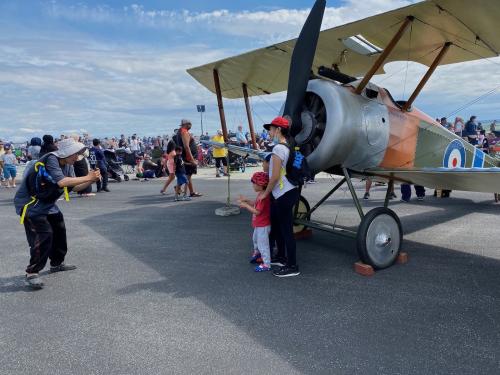
Abbotsford Airshow

The 'green machine' was a favorite for photo ops for young and older...


Chilliwack Flight Fest


Out in the cold...



Around the hangar...

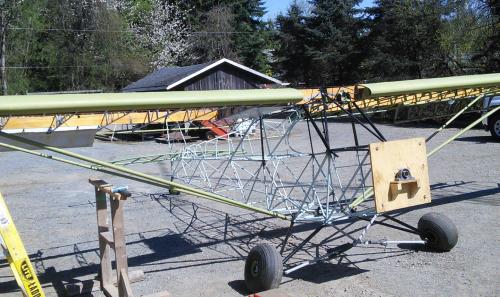

de Havilland Gipsy Queen, is the descendant of the 4-cylinder Gipsy Major in the Museum's Tiger Moth.

Around the hangar...


Experts will dismantle the engine, test every part and re-assemble.

We are open Wednesday to Sunday, by pre-booked time slots.
- Wednesday through Saturday from 10:00 a.m. to 4:00 p.m.
- Sunday from noon to 5:00 p.m.
Our facility is ideal for family outings during these challenging times, as we have ample space and large outdoor areas.
Around the hangar...





TCA 810, Anatomy of a Disaster
The Museum has received a book review (thanks to Jack Schofield of Coast Dog Press) by a retired airline pilot who was very much involved in this aviation scene. Read on...
Donation of old aviation photographs
If you are cleaning out historical items please consider donating them to your local museum or historical society. If the items relate to the history of aviation in BC please consider the Canadian Museum of Flight in Langley, BC or the BC Aviation Museum in North Saanich, BC.
To help us understand our aviation history more completely we would appreciate hearing from those in the know on such matters.

two of these on Vancouver-Seattle in 1936 until they were passed on to TCA.



Is your father/uncle/grandpa here? Do tell.
TCA 810 Anatomy of a Disaster
On a stormy winter night in 1956 an airliner went missing in the Cascade Mountains near the Fraser Valley. Author Rien van Tilborg spent many years researching this disaster and has just published a detailed account.

Around the hangar...





Restoration news


Stearman on display
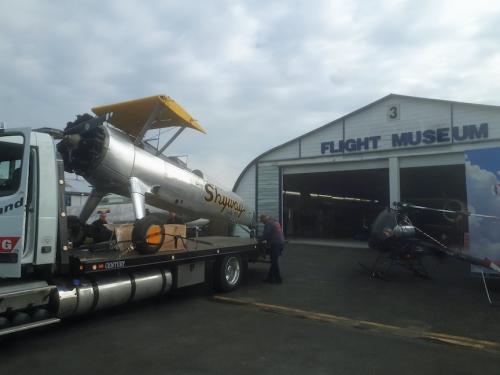


Anniversary of first Trans-Canada flight

October 17 marked one hundred years to the day that the first trans-Canada flight took place. In a letter to the Victoria Times-Colonist, Colonel John L. Orr (Ret’d) points out that a British-built Airco DH.9A biplane took off from Shearwater, Nova Scotia (Newfoundland was not yet part of Canada) and touched down in Richmond, British Columbia’s Minoru Park at 11:25 on October 17, 1920, completing the epic coast-to-coast flight. The flight continued to Esquimalt, a suburb of Victoria, arriving on Oct. 21.
According to Orr, the flight was organized by the Canadian Air Board, a federal government department that lasted from 1919 to 1922. It was formed to develop and promote both civil and military aviation in the post-First World War era.
“As for the Air Board’s objective of stimulating interest in aviation in Canada, the flight proved to be successful,” wrote Orr. “While the path was neither straight nor smooth, the trans-Canada flight firmly established aviation, both civil and military, in the Canadian psyche.”
The Airco DH.9A was a single-engine light bomber that saw service in Britain’s Royal Air Force toward the end of the First World War. The first aircraft out of the factory, the DH-9 were powered by the in-line Siddeley Puma six-cylinder engine, which proved to be unreliable and not powerful enough. The 12-cylinder Liberty engine, of American origin, powered the DH-9A.
Retirement of the Boeing 767 from Air Canada

On June 2, Air Canada operated its last Boeing 767, one of 48 aircraft that proved to be workhorses for almost 40 years, on AC439 from Montreal to Toronto.
The first of the 767s was delivered in 1982 (fin 601) and another 23 were added to the Air Canada fleet after the merger with Canadian Airlines in 2001. The wide body 767s also flew to destinations in Europe and the Caribbean with Air Canada Rouge.
FACTS ABOUT THE 767
• Air Canada Boeing 767 fin 682 (C-FCAE) registered over 138,000 flying hours before it was retired on Aug. 1, 2019, making it the world leader in terms of flying hours for the fleet type.
• The 767 was the first aircraft to receive 120-minute ETOPS (extended twin-engine operations) approval in 1985, meaning it could operate two hours away from the nearest airport, making oceanic crossings more efficient. This was increased to 180 minutes in 1988.
• The longest scheduled non-stop flight by an Air Canada 767 was Toronto to Tokyo, which lasted 13 hours and 45 minutes and covered 10,324 kilometres.
Restoration

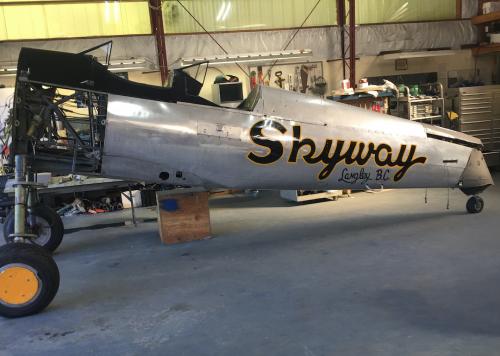
de Havilland DHC-2 Beaver


Around the hangar - rust removal


New display signs at Museum
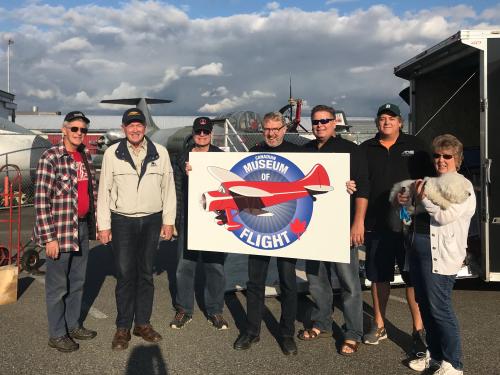
in the unloading/loading process.
The Camel in Vancouver

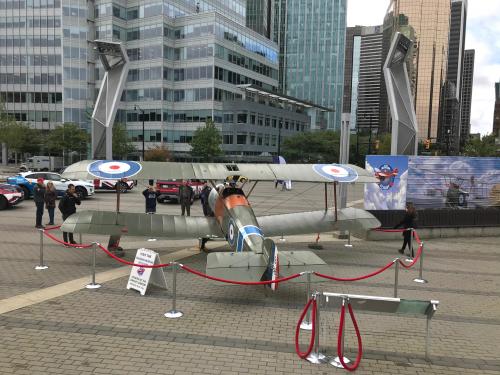
Chilliwack Flight Fest 2019


A technical problem being overcome just before departure.

Gord, Al, Jim, Vic and Bill posing beside the Sopwith Pup 'Happy.'

This is the pilot's view from the SE5a while cruising down the Fraser Valley.
the central black object is the upper gun mount. Oh yes, there are also lots of wires
and struts that hold the upper wing to the airframe.
Visibility for landing is... well, we could say it is a challenge!
Fortunately, we don't have to look out for red Fokker Triplanes...
Around the hangar

Bill and prop-swinger, Dave set the time machine in motion.

stage 2 is in progress. Fine grit is used, followed by machine polishing.
Oh, the aching muscles! Can you help with arm power? Call the Museum.

makes all the right connections to get it ready for flight again.

one wing low. Rigging of biplanes is done 'by the book' but sometimes the books are
sparse on details. Here, Bill straddles the plank, while Al fits locking wire.

trial-fitted to ensure the multitude of wires, fittings, nuts and bolts are all accounted for.
Once this is done, the wings will be removed and painted. Experience has shown this is the only way
to treat a restoration of this magnitude! Ray, Bill, Dave and Alf are shown as the work progresses.
A model of another de Havilland product, the Mosquito, supervises from on high.
Abbotsford Airshow 2019



de Havilland Vampire seems to share the same sentiment.
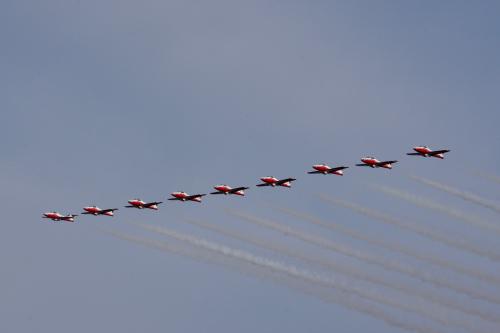
if you had to fly at 400 km/h while looking out the side window?


Around the Hangar


Cloverdale Market Days

Father's Day 2019 at the Museum
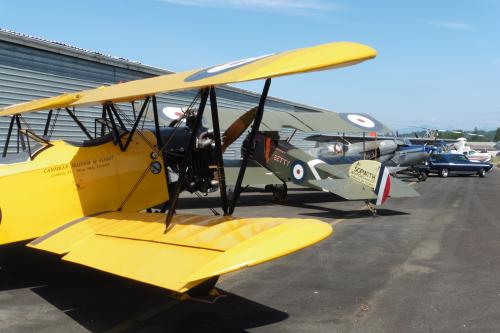



the Rumbold Group in appreciation of their sponsorship of the Waco AQC-6 in the background.


copilot Sasha Pihl observes. Sasha and his father drove from Kelowna especially to ride
in the classic 1937 aircraft. You could do the same! Check out the Sponsor Aircraft tab on this website.
Pitt Meadows Airport Day




Spring Training Camp



before the start of the flying season.
The Stearman flies

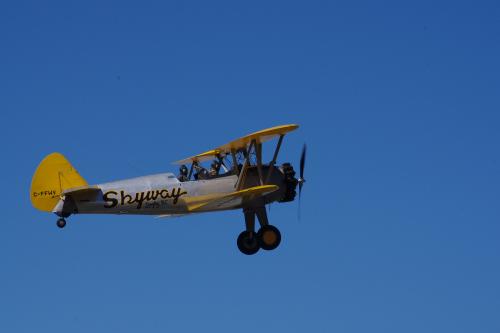


The Boeing 747 is 50 years old.

The increasing popularity of air travel motivated Boeing to create the largest civilian plane in the
world in the late 1960s. The result was the Boeing 747 jumbo jet, which made its first test flight on
February 9, 1969.
Named the “City of Everett” for the city it was built in, the first 747 was piloted by Jack Waddell,
who flew with co-pilot Brien Wygle and flight engineer Jess Wallick. It took flight at 164 mph, circled
the airport at 2000 feet then climbed to 15,500 where tests were performed. After about an hour in
the air, it returned to Paine Field.
Further testing revealed the JT9D engines were underpowered for the plane's weight and size,
which caused delayed deliveries in the early 1970s, but the Boeing 747 was certified by the FAA on
December 30, 1969.
and Boeing got to work. The company built the largest building in the world by volume in Everett,
WA to construct the 747. Electrical engineer Malcolm Stamper was tasked with leading a team of
over 50,000 people to develop and build the 747, which they did in less than 3 years.
The design required 4.5 million parts, used 75,000 engineering drawings, and built on the highbypass
engine technology that had been developed for the C-5A gigantic military transport plane.
The original 747 had a 195-foot, 8-inch wing span and a swept-wing design that set the wings at 37
degrees for high cruising speeds over long distances. The nearly 232-foot plane had a 225-foot
fuselage and a tail as tall as a six-story building. It weighed in at 735,000 pounds, twice the previous
Boeing 707 model.
Different 747 models have been modified to serve as Shuttle Carrier Aircraft for NASA, Air Force
One, and the Dreamlifter, which transported large composite structures, like fuselage sections of the
787 Dreamliner, to Everett, WA and other facilities for final assembly.
Boeing delivered the 1500th 747 to Lufthansa in Germany in 2014, and has produced 1540 planes as
of November 2017, but The Wall Street Journal reported the company has considered ending
production due to declining orders.
Trainee Aircraft Mechanics




In the Hangar


inner spaces of the Waco Cabin to retrieve an article dropped by a passenger.

the inner working of each aircraft can be examined, adjusted, repaired or replaced.
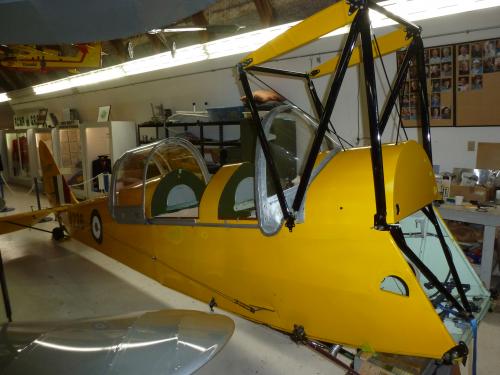
has been removed, overhauled and refitted. The upper wing centre-section mounting struts
(known as cabane struts) have been fitted in preparation for mounting the fuel tank and wings.

Good skills for them, good display for us. It will house a display of Wardair memorabilia.
Were you associated with Wardair? Give us a call.
Out of the Hangar
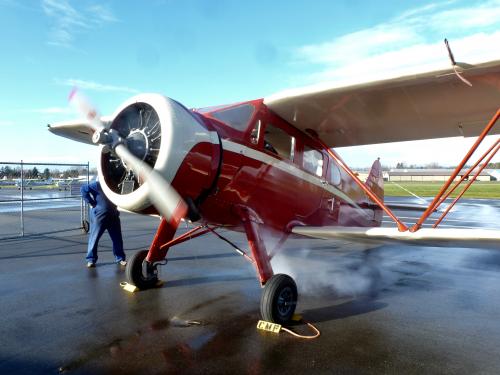

Remembrance Day 2018
The Museum participated in flyovers in the Fraser Valley.

Kinner 5-cylinder radial engine and the wooden propeller are evident.



Into The Wild. The Museum's 2018 fundraising event
On 15 September the Museum held a fundraising event at the hangar in Langley. Volunteers moved the display aircraft outside and tied them down securely with the promise of the usual fall wind and rain. Floors were scrubbed, tables and chairs set up and a giant mural of an Arctic Air DC-3 in a hangar was secured to the hangar door. Tables for reception, auction items and food service were arranged. By 5pm guests were arriving and checking out the items on auction. At 6pm the food was served - delicious salmon and beef from Chef Simon of 5 Star Catering. By 7pm the auction was underway with spirited bidding on many items with DJ and auctioneer, Scott Barratt, keeping the momentum going.

He is wearing the traditional northern garb of fur-lined parka and genuine mukluks.
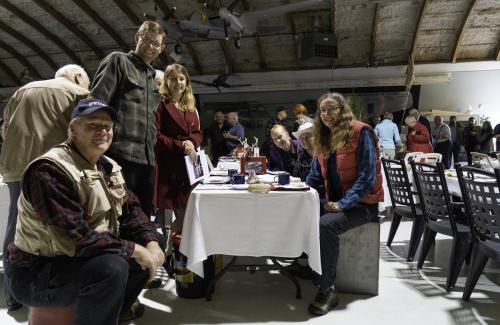
on packing cases and oil drums...


with Dr. Jack Pickup. Dr. Pickup's Waco biplane is owned and flown by the Museum.

the Avro Anson on the Arctic coast through to the Boeing 737.

Linda and Dave Beales take a trip down memory lane.
Fall 2018 update
The Museum’s participation in the airshow scene is coming to an end as summer wanes. Important events that the Museum sales and flight crew attended were at Pitt Meadows, Boundary Bay, Abbotsford and Chilliwack. Hundreds of thousands saw the Museum’s participation – either in person or through the social media. Check it out on YouTube.
What has been going on at the Museum, you may ask? The staff and volunteers take time out of their busy summer schedule to keep things happening. Did you know that a crew of volunteers have patiently sanded and painted the picnic tables and walkway rails – and taken time to water the planter boxes? Another group have worked in the blazing sun to keep the classic DC-3 in top shape. Others have painstakingly sorted photographs, books and memorabilia and logged it all into the Museum’s inventory. Others have used their skills to overhaul the equipment in the adjacent café to meet health regulations. Of course, having airworthy aircraft is a challenge all of its own. The aircraft must be maintained to full airworthiness standards as though they were in daily use at a flight school, and the pilots must pass the medical and technical standards to keep the old birds flying.
Do you want to be part of this activity? Casual volunteering for airshows or events may suit you better within your work schedule. Want to see an airshow from the inside out? Next summer plan on joining the crew as they prepare the sales stock, pack it in vehicles and set up the sales booth. And then get to talk to a very interesting group of spectators. After all, they are at an airshow because they are interested in aviation. Some are veterans of decades in the industry with stories to share, while the three-year-olds are taking their first ‘flight’ in the Museum’s toy aircraft. Come and join us!
Abbotsford Airshow 2018
Friday was busy with setting up the sales booth and ferrying the aircraft to Abbotsford Airport. The three Museum aircraft participated in the flying displays on Saturday and Sunday.



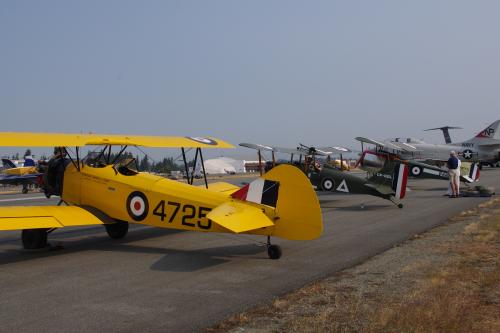
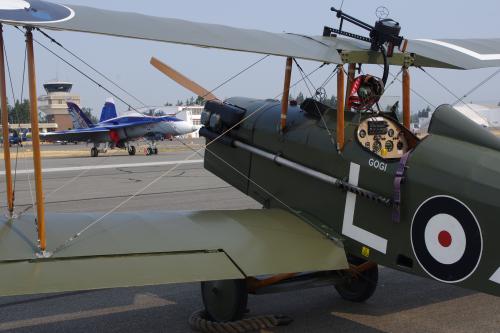

demonstrating the diverse interests and experience of Museum volunteers.
Boundary Bay Airshow 2018
The annual airshow at Boundary Bay - to the southeast of Vancouver International Airport - was a great success. Not only was the weather excellent, but the participation by international organizations and the public was first class.
The Museum flew three of its collection from Langley to the airshow - the 1940 Fleet Finch biplane, the 1955 Fleet Canuck trainer and its recently built Sopwith Pup replica. The Museum's sales crew were kept busy with selling aviation memorabilia.
So why was the volunteer near the deadly propellor in the photo on the Home page? This Finch biplane has no built-in electrical system. That was too much of a luxury for the RCAF in 1940! So each time it goes flying the engine has to be started by a trained volunteer swinging the propeller until the engine roars into life. Special training - and steady nerves - are required for this task. But with a rigid protocol of calls and hand signals the engine can be started safely.
A huge Canso flying boat was on display. This WW2 aircraft, based in Victoria, BC, was a common sight in these skies at one time. From the US came a trio of interesting warbirds from the Erickson Collection - a Corsair, a Bf 109 and a Grumman Hellcat. Amazing displays of aerobatics and skydiving filled the program for several hours.

The airshow is very much a family affair.
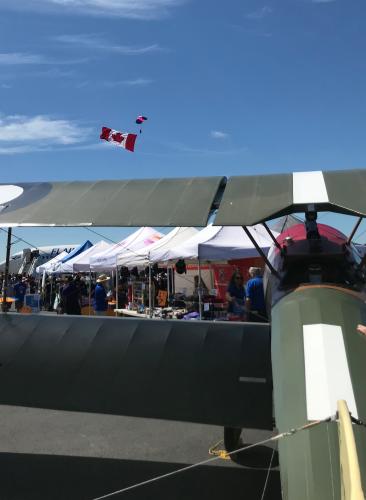

Yellow Thunder with two Harvard aircraft.
Pops and Props 2018
Blue skies and a happy crowd made this an event worth repeating. Watch for it next year on Father's Day.

Pops and Props was very much a family event.


Pitt Meadows Fly-in
On 2 June, 2018 the Museum participated in a fly-in at Pitt Meadows Airport.
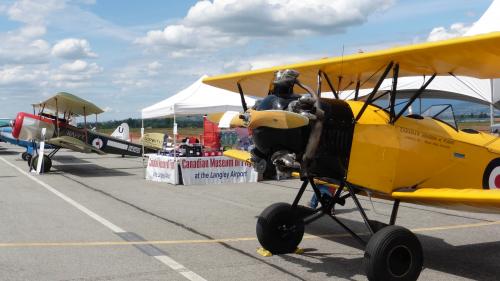

that were worn by the Aero Club of BC's training aircraft in the 1960s.


qualities of their aircraft.

enthusiastically gave up their free time to participate in the event at Pitt Meadows.
In the Hangar
Technical projects continue steadily in and around the hangar. The restoration of the Museum's DH82C Tiger Moth has taken a step forward with the completion of the repairs to the forward fuselage and the application of the yellow finish. Of course, underneath the standard Air Force trainer colour are layers of finish and UV protection that are all sprayed on with painstaking precision.
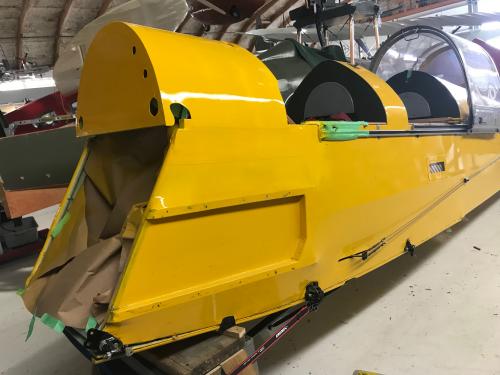
that is then sprayed with multiple layers of special finish.


powered (and still powers) the iconic aircraft. Did you know that 200 Piper Cubs were built in Ontario?

Annual General Meeting 2018
Westland Lysander

Spring skies
The Museum's grand old Douglas DC-3 is glittering in the spring sky. Refurbishment work over the winter includes recovering the flight controls with new fabric. Typical of aircraft of this era, the all-metal DC-3 has fabric covered ailerons, elevators and rudder. The elements are hard on these surfaces and a time-consuming project is under way to keep the old flyer in top condition.
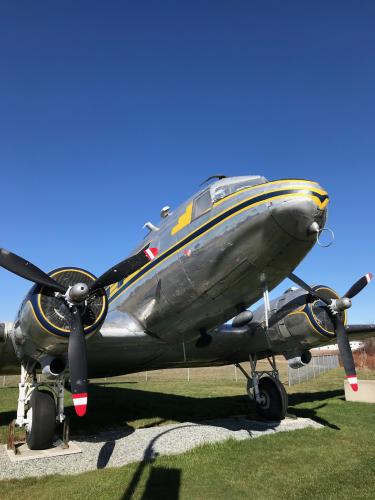
Family Day at the Museum



where our guests could drop their love wishes to Cupid into the airmail bag.
The Love Expeditor departed Valentine's Eve. Destination: Cupid's Cloud (Runway XOX)!

The jar contained 610 beans. Laura won the beans and a year's Family Membership to the museum.
SE5A on display in Vancouver
We wish HJU:Z the greatest success!

flowers blooming just a few weeks before Christmas?

The aviation experience level is probably hundreds of years...

Remembrance Day
The Museum participated in the Remembrance Day services by flying one of the Sopwith Pup replicas that were so carefully constructed in the last two years. Pilot, Bill Findlay, braved the wintery skies and flew over Delta, South Surrey and Langley.

Pups for Pups
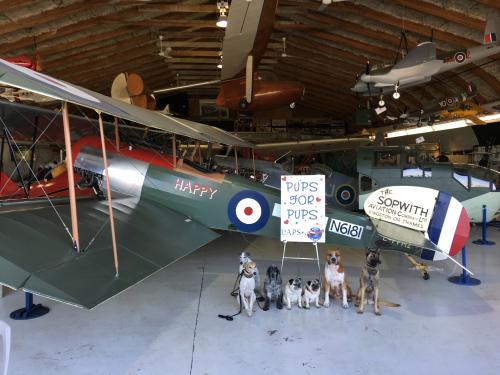
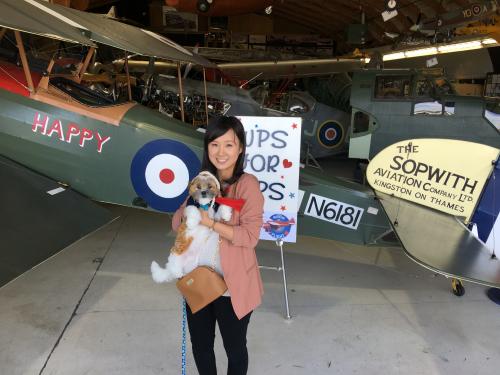

Air Canada
Air Canada news release:
“On September 1, 1937, Air Canada (then Trans Canada Air Lines) took wing with a Vancouver-Seattle flight. The plane, a Lockheed L10A, weighed a little more than half of what a single engine on our biggest Boeing 777 does. In our first full year, we flew 2,086 customers, not even two per cent of the number we now carry on a moderately busy day. Our company has grown exponentially over its 80 years, and so many generations of dedicated employees have taken Air Canada from strength to strength to industry-leading innovations in safety, passenger comfortable and efficiency. This includes being the first airline to install aircraft deicing nozzles, the first to make its North America-Europe flights non-smoking (followed by a total smoking ban), and the first to use a computerized reservations system.”

This type initiated the first flight for Trans Canada Air Lines 80 years ago.
The flight was between Vancouver and Seattle.


Canadian Geographic Society presentation
The Canadian Geographic Society was one of the major players at the Vimy Ridge Centennial Commemoration. On 23 August they sponsored a seminar for Vancouver-area history teachers at the Museum. They had huge 9m x 12m maps laid out on the hangar floor while they did a small scale tour of the battlefields. Museum docent, Matt Offer, then conducted a tour of the museum after which the teachers enjoyed a hands on tour of our two Sopwith Pups. The two Pups then went for a ten minute local flight to show off the airplanes.






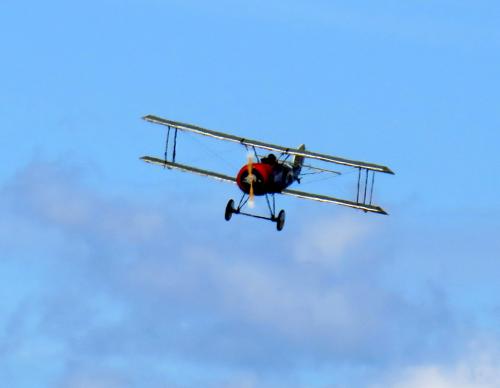
The Big Chill

This event on Saturday, 29 July was a day out for aircraft fans - and ice-cream lovers!

The program started with the ageless aviation event of a fabric-covered biplane being started by hand in front of the crowd. The cry of 'Contact' was followed by the mellow rumble of the Finch's 5-cylinder Kinner radial. A more modern touch was provided by the press-button start of the Museum's Sopwith Pup replica that proceded to take to the skies for a flypast. Then there was the smoke and roar of the Harvard's 600-hp Pratt & Whitney Wasp engine as it filled the hangar with freshly-burnt aviation oil.

Have you ever wondered what pilots look at when they do their pre-flight ritual? It was all explained by instructor David McIntosh with a young 'student pilot' in tow.

The crowd was able to shelter from the scorching sun in seating in the hangar while watching the events - and taste the delicious ice-cream treats - thanks Carla.
Boundary Bay Airshow 2017
The Museum was, once again, a participant in the Boundary Bay Airshow. Two of its flying collection were included in the flypasts along with many other classic and modern aircraft. The newly restored Fleet Canuck was attending its first airshow, as was the new-build Sowith Pup replica. The grey skies and occasional sprinkle did not damp the spirits of the large audience.


The aircraft, built in Quebec in 1943, paid tribute to the wartime service of
RCAF Flight Lieutenant Edward Scott.

from the Erickson Aircraft Collection in Oregon.


Gleaming in the sun

Thanks to Peter and Alf for their dedication in the hot sun.
If you are tired of watching the plants grow at your favourite coffee shop,
come join us as a volunteer and bring some aviation history back to life.
The Pup flies over the mountains.
The label by the censor of, "somewhere over France," does not apply to these shots of the Pup in the local mountains to the north of Langley Airport.


Museum at Langley Aero Club Fly-in
The Museum was well represented by some of its classic aircraft on Saturday, 17 June at Langley Regional Airport. The Pup, after arriving from Abbotsford, joined its fellow flyers on display.

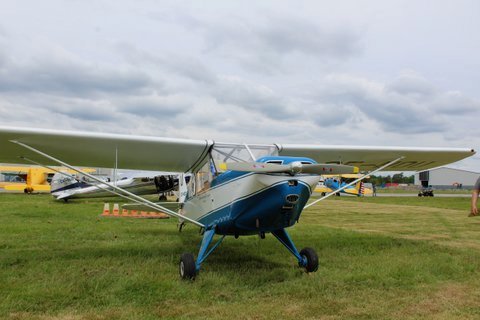


of this colourful Langley resident - a Beech 17 Staggerwing.
Sopwith Pup returns to Langley
The Museum's Pup 'Betty/Phyllis' flew into Langley on Saturday, 17 June from Abbotsford. Since leaving in a dismantled state on March 11, the Pup has traveled 17,000km to Lille, France for the Vimy commemoration and back to Langley. Of course, this little machine could not have done it without the cooperation of many friends, especially the RCAF transport squadron.





The aircraft involved in the Vimy Remembrance are now back home


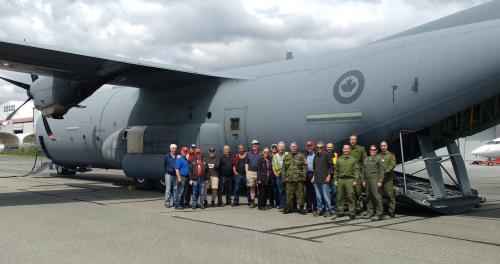
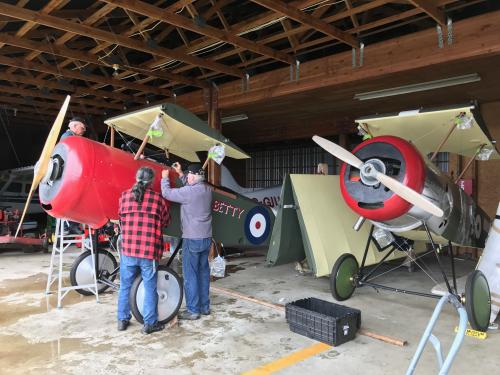
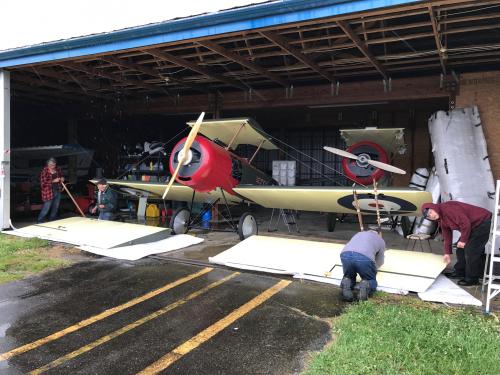

Letter from the Township of Langley
The Mayor of the Township of Langley, Jack Froese, has sent the Museum a letter of appreciation for its contribution to the 100th anniversary of Vimy Ridge.
2017 Museum Annual General Meeting
The Museum held its 2017 AGM on 6 May at the Hangar in Langley, BC. A light meal was served followed by the business meeting.


in recognition of his dedication in overseeing the construction of the Sopwith Pup aircraft.
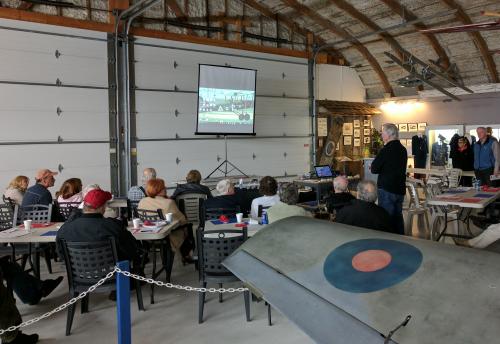
The video was prepared by Museum volunteer Al French.
Relocation of storage containers.


such as tables and chairs, was brought within the perimeter fence.

The company has been a good friend to the Museum for over 20 years.
Flypast at the Vimy Memorial


recreating the flight at the opening of the Monument in 1936.

The Pup that Museum volunteers built is on the right.


Museum crew in action at Vimy

The colour scheme honours pilot, Lt-Cdr Lloyd Breadner, of Ontario.
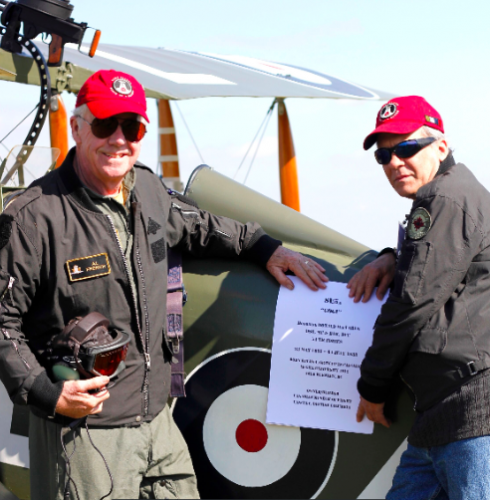
The markings honour pilot, Captain Donald MacLaren, of Ottawa.

The colour scheme honours the pilot, Flt-Cdr Joseph Fall, of Vancouver Island.

April 9, 2017: Unveiling of "Victory At Vimy Ridge"


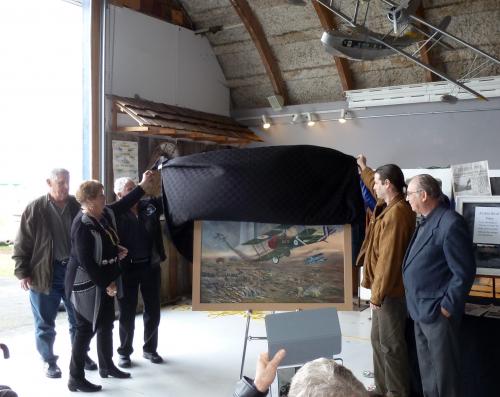

Joe Fall's Sopwith in action over the trenches.

Canadian monument to the Battle at Vimy Ridge.
Museum Pup in France

Low-flying DC-3



to its final destination adjacent to the new Museum location.
A big "Thank You" to Maxum Cranes and Ivan for lifting our very special DC-3 with care and professionalism.

2017 Gala




Pretty Estates Resort Fraser Blues Formation Flying Team
Chinook Helicopters Harbour Air Seaplanes
Air Canada Forbidden Vancouver Tours
Backyard Vineyards Allan Snowie
Fitness Unlimited Health Club Jade Fine Foods
Shoppers Drug Mart Lee Hall Epicure Consultant
George Kirbyson Carla Deminchuk
Langley Golf and Banquet Centre MotoArt
Von euw BREW Key Largo Jewelry
Koch Greenhouses David Valentine
Museum artifact cooperation
The Museum continues its efforts to cooperate with other museums by trading items that are surplus to the Museum's needs. Although we had a Frazer-Nash gun turret from a Lancaster, there was not much chance of us gaining a Lancaster to go with the turret. The solution was to send our turret to Windsor, Ontario to be fitted to the Lancaster being restored at the Canadian Historical Aircraft Association.
Around the Museum


More information on the Struchen at;
www.canadianflight.org/content/struchen-ultralight-helicopter


are the team who refurbished the Struchen (rear) and Bensen (front).
Actually, they will restore anything that flies or wheels its way!
Vimy Flight

Don't forget to check out the Vimy Flight website
Vimy Flight




Note: for earlier progress reports, see Collection: Sopwith Pup Replica - www.canadianflight.org/content/sopwith-pup-replica
The Skyways Stearman.
David Seller, son of Skyways founder, Art Seller, donated the aircraft to the Museum at a signing ceremony on 3 November, 2016. Accompanying him were several people who were associated with the original Skyways staff.

on 9 November by Museum President, Bruce Bakker.
www.canadianflight.org/content/art-seller-and-skyway-air-services-ltd
A Nation Soars:
The Canadian Museum of Flight, in association with Sound Ventures and The Royal Canadian Geographic Society, are participating in the First World War commemorative project Wings of Courage, and Flight Path of Heroes as part of the 'A Nation Soars' program. The CMF is tasked with building, then flying, two replica Sopwith Pup biplanes. After completion of the first Pup the two planes were formally gifted to the CMF to become part of a permanent exhibit.
As part of this program, two replica Nieuport fighters will team up with the Museum aircraft as Vimy Flight. More at www.facebook.com/groups/1682903768639218/
For information on how to donate to help Vimy Flight succeed, go to:
www.canadahelps.org/en/charities/canadian-museum-of-flight-association/canadian-museum-of-flight-vimy-ridge-100th/
Note: for earlier progress reports, see Collection: Sopwith Pup Replica - www.canadianflight.org/content/sopwith-pup-replica
************
The Official announcement of The CMF participating in A Nation Soars.
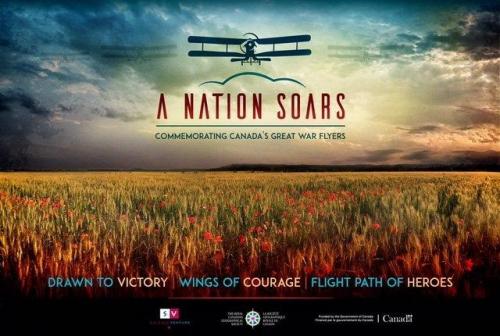
The Canadian Museum of Flight, in association with Sound Ventures and The Royal Canadian Geographic Society, will be participating in the First World War commemorative project Wings of Courage, and Flight Path of Heroes as part of the 'A Nation Soars' program. The CMF is tasked with building, then flying, two replica Sopwith Pup biplanes. Once completed, the two planes are to be formally gifted to the CMF to become part of a permanent exhibit.